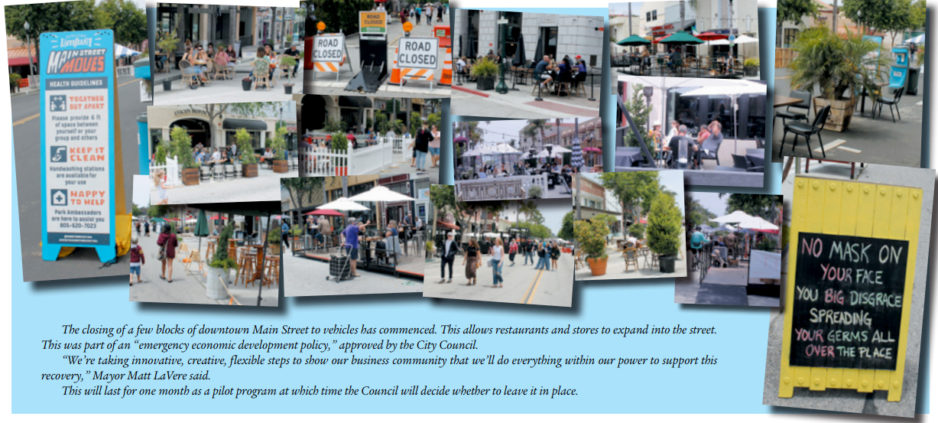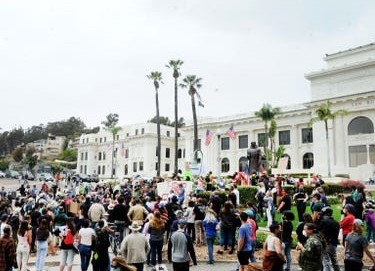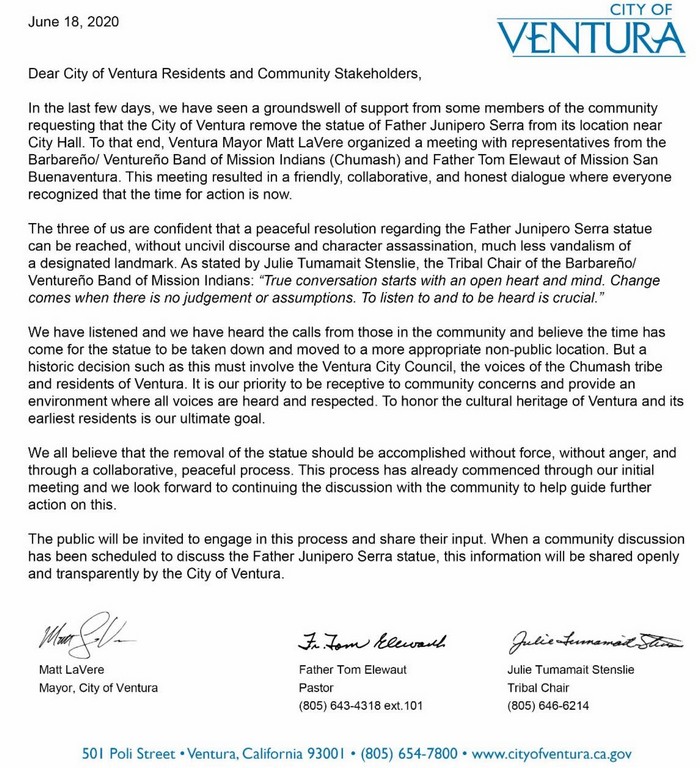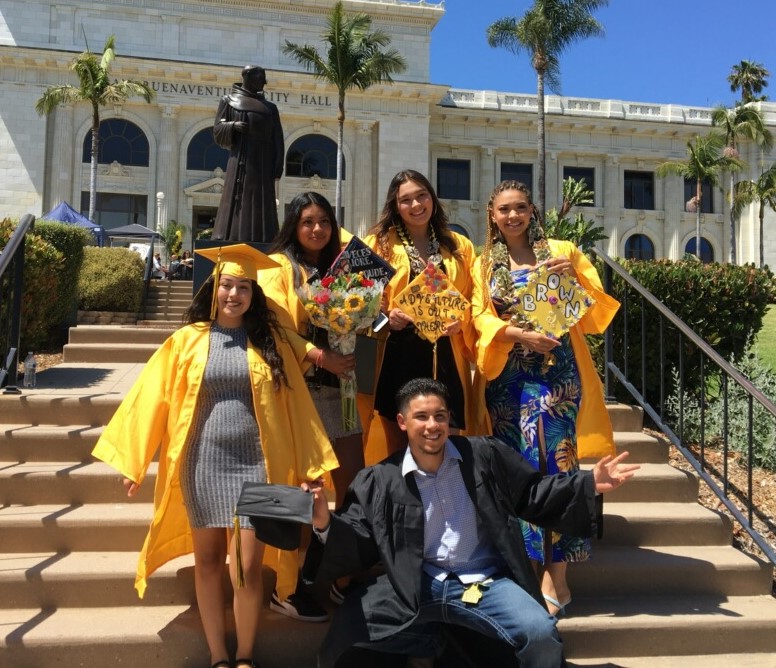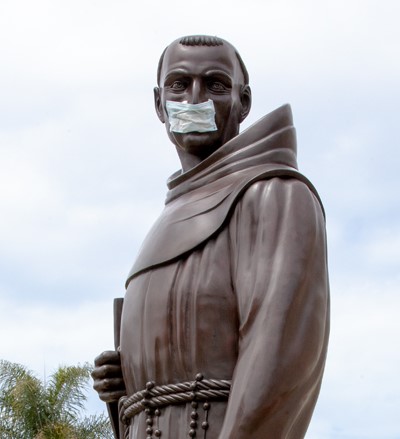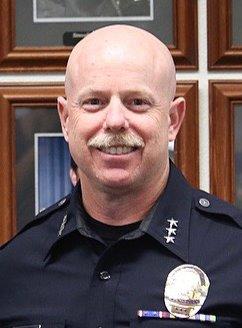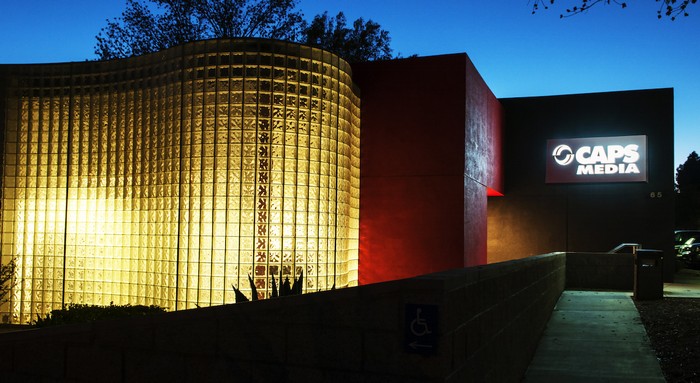The closing of a few blocks of downtown Main Street to vehicles has commenced. This allows restaurants and stores to expand into the street.
This was part of an “emergency economic development policy,” approved by the City Council.
“We’re taking innovative, creative, flexible steps to show our business community that we’ll do everything within our power to support this
recovery,” Mayor Matt LaVere said.
This will last for one month as a pilot program at which time the Council will decide whether to leave it in place
All posts by admin
Will Father Serra statue be moved?
About 200 people attended a protest at the statue.
A demonstration was held. on Saturday, June 20, to demand that the statue of Father Junipero Serra in front of Ventura City Hall be taken down on grounds that he had committed atrocities against Native Americans, including the local Chumash.
Father Serra is credited with bringing Catholicism to California but many blame him for what they say were his efforts to do away with Native American culture in California and for the premature deaths of thousands of indigenous people.
Ventura Mayor Matt LaVere, representatives from the Barbareño/Venureño Band of Mission Indians and Father Tom Elewaut, the pastor of Mission San Buenaventura, agreed and issued a joint statement agreeing to take down the statue and have it moved to a more appropriate non-public location. See copy of it in this issue.
“We have listened, and we have heard the calls from those in the community and believe the time has come for the statue to be taken down and moved to a more appropriate non-public location. We all believe that the removal of the statue should be accomplished without force, without anger and without uncivil discourse, much less vandalism,” the joint statement reads.
Tension built for a time at the rally as a group formed a ring around the base of the statue to protect it from being taken down. Ventura Police Department patrol units arrived and the tension subsided. The protest concluded peacefully with no arrests or further problems.
Those gathering represented a mix of views. Those who want it removed and those who think it is an important part of our history and should remain where it is.
Speakers included Chumash elder Julie Tumamait-Stenslie, tribal chair of the Barbareño/Ventureño Band of Mission Indians and Tom Elewaut.
The first statue was created by John Palo-Kangas in 1936. It was replaced in 1989 by a statue made from the wood carving by the late Wilbur Rubottom that is on display in City Hall atrium. Rubottom Cabinets is still located in Ventura and run by members of his family.
Elewaut said “I can’t say that I agree that the statue should come down. But I will acquiesce to it if it helps bring some healing to the present-day Chumash community. Father Serra saw himself as a spiritual father for the indigenous people. Were people decimated? Yes. I understand the hurt and the loss of culture that the indigenous people experienced.”
“In recent weeks, the City of Ventura has received a groundswell of feedback from the public on the Father Junipero Serra statue. We want the community to know that we are receptive to their concerns and seek to provide a peaceful environment where all voices are heard and respected,” stated Ventura City Manager Alex D. McIntyre. “This is an historic decision and must involve the voices of the Chumash tribe, the Mission San Buenaventura, residents of Ventura, and the City Council.”
The public is invited to join the Ventura City Council for a virtual community discussion on Tuesday, July 7, 2020, at 6:00 p.m. about the Father Junipero Serra statue. The special public meeting will include the Ventura Mayor, City Council, and city leadership.
You can share written responses online by visiting www.CityofVentura.ca.gov/FatherSerra. All responses will be shared with the City Council.
Once removed the big question is where should it be relocated? The Breeze would love to hear our readers thoughts at [email protected].
Ventura High School Celebrates At-Risk Graduates
Graduating students were all smiles.
by Sheli Ellsworth
Before COVID-19, the term “at-risk” was used to identify students that were having difficulty in school and at risk for dropping out. One out of ten California students will drop out of high school before graduating.
“Out of around 2000 students, we had about 60 students who were recognized by a counselor, teacher, parent or coach as having lots of potential but who were either struggling, underperforming academically, economically, socially, or attendance wise,” says Ventura High School Principal Carlos Cohen. Cohen contacted the Police Activities League (PAL) with an idea. He wanted to bridge any gaps students might have faced in their lives by coaching, mentoring and teaching them the skills they need to get ahead. In April 2019, a joint project Levin named “Learning the Ropes” or LTR was launched.
Students who normally would have been suspended for truancy, vaping, pot smoking or classroom violations had the choice of attending semi-monthly lunchtime workshops or suspension. “Freshman students in LTR also have access to a VHS Den Mentor—junior and senior students who have volunteered to mentor freshmen.” Thirty-five students decided to attend the LTR program. Only four students chose suspension.
PAL members Sal Flores, Ben Schuck, Jeanette Sanchez, Frank Benavidez, J.R. Luna, Joseph Hoss, Annette Garcia, and Lorelei Woerner took on the challenge. “About four or five of us went at a time, says Flores.” At first the students were really distracted, some were disrespectful, and some outright rude. Eventually, they started to listen.” Flores says the workshops focus on subjects like: Never Give Up; You Can Achieve Anything; Wealth and Happiness are Two Different Things; Goal Setting—Make a plan; Take 100% Responsibility for Your Actions; You Earn It—You’re Not Entitled to It; and What is the Real Problem?
Flores says that just showing up for the students is key and more than some working parents are able to do. “We care about them, we believe in them, and we make time for them—which is better than some students get at home.” Many Learning the Ropes students are from broken homes and blended families where alcohol and drugs interfere with normal functioning. “Some of the at-risk kids are just financially challenged and don’t know where to go next. We help them navigate their next step whether it be college or a trade school. We look for scholarships and sponsor field trips to postsecondary schools to get them comfortable with the idea of continuing their educations.” One of the most important lessons taught is: No more excuses! Today is the day to make changes.
On June 13, six of the nine LTR seniors graduated from Ventura High School. “Two more are making up credits this summer and will graduate in August,” according to Levin. One of the June graduates is Destiny Sausedo.
Sausedo grew up in a gang-infested neighborhood where shootings were commonplace. She has lived through the death of her brother in a drive-by shooting and the loss of her mother to a drug overdose. Eventually she landed in foster care then a group home. “I found the meetings motivational. I left with a new sense of purpose,” Sausedo says. She had no idea so many kids were dealing with so many problems. “Some of us needed help and didn’t even know it.” Sausedo advises other at-risk teens to never give up. “I have a saying: God picks the strongest soldiers for the toughest battles.” Sausedo’s next goal is to attend Ventura College and eventually become a therapist so she can help kids like her.
For more information about PAL and Ventura High School’s Learning the Ropes program contact Sal Flores 805.651.8647.
City Council will require masks
Father Serra was wearing a face mask before it was the law.
On a 4-3 vote the City Council will require masks to be worn inside businesses and government offices, on public transit and in most indoor venues that are open to the public. This order will go into effect once the City Council approves the final ordinance which will be considered at a future meeting.
The city manager will need to draft an emergency ordinance to lay out the details of the new order. It will be modeled on a similar order in Santa Barbara.
Councilmember Erik Nasarenko stated “masks have become such a common feature that I don’t even think people question it anymore. Ultimately it’s not about discomfort or inconvenience, it’s about doing whatever we can in whatever way possible to limit the spread of a highly infectious and deadly disease and if that means wearing a face covering, I think we should do it.”
Nasarenko, along with Councilmembers Cheryl Heitmann, Sofia Rubalcava and Christy Weir voted in support of the order. Mayor Matt LaVere, Lorrie Brown and Jim Friedman voted no.
Brown and Friedman voted no because they question the city’s ability to enforce the use of face coverings in businesses.
Police Chief Darin Schindler said enforcement of the policy would not be a priority for the department.
“I would obviously put communication in front of enforcement. I just don’t think it’s a viable option right now to expect us to contact people for purposes of enforcing them wearing a mask. It’s going to put our officers in a difficult situation especially with the current climate surrounding the use of police authority right now.”
Violations of the mask order would be handled through the city’s emergency action citation process, the same way that violations of other pandemic-related health orders are handled. Ventura plans to focus on education to try to obtain voluntary compliance from the public. But if that doesn’t work, a written warning may be issued, followed by an administrative citation.
So, basically this is just symbolic.
We have so much to learn from black elders
— and so many reasons to support them
This blog originally appeared on the Diverse Elders Coalition website.
by Jenna McDavid – from February 6,2018
February marks the start of Black History Month, a celebration of Black and African American stories, experiences, and impact on American culture. At the Diverse Elders Coalition, we’re proud to celebrate Black Elders every month of the year, but February offers us a bonus opportunity to lift these stories up into the national spotlight. Black Elders have so much wisdom to share about our history and the ways they have challenged white supremacy and other forms of oppression. It is imperative that those stories are not lost or forgotten.
I recently (2018) attended a Capitol Hill Briefing about the Senior Community Service Employment Program (SCSEP), during which we heard testimonials from community-based organizations that employ older adult workers through the federally funded program. SCSEP placement not only provides employees with meaningful work, wages, and socialization, but also gives these organizations staff to help them continue to serve their communities.
Diverse Elders Coalition partner, the National Center and Caucus on Black Aging, is a primary grantee for SCSEP, providing employment opportunities for African American older adults across the country in community-based service organizations like TERRIFIC, Inc. in Washington, DC. Sharron Holquin, a SCSEP participant who spoke at the briefing, talked about the lifetime of employment experience she brings to her current employer, and how we shouldn’t dismiss older adult workers because of ageist assumptions about their abilities.
I came away from this briefing with not just a greater appreciation for SCSEP, but also a framework that I hope to bring with me into my work with the Diverse Elders Coalition — and beyond. When talking or working with diverse elders, younger generations must always ask ourselves: What assumptions are we unfairly making? What stories are we missing because we didn’t think to ask? And what can we do, each day, to better honor and support the elders who have paved the way for our generation?
Stay tuned to the Diverse Elders Coalition blog all month long for Black History Month contributions from our incredible writers and guests from around the country. And in the meantime, check out some of these Black History Month highlights from years past:
A Gift From My Grandmother: An Embrace of Life — and Aging by Jeneé Darden
SELMA: 50 Years Later by Mandy Carter
You won’t believe what I learned from our black elders by Bryan Pacheco
Black, Gray and Gay: The Perils of Aging LGBTQ People of Color by Chandra Thomas Whitfield
Housing For Diverse Elders is a Public Health Issue by Dr. Imani Woody
The Ventura Police does support peaceful protests
‘I support any movement that supports equal rights’
by Carol Leish
Ventura Police Chief Darin Schindler stated, “The current Black Lives Matter movement does focus on the rights that all people have, and the idea that everybody deserves to be treated fairly and with respect. In my opinion, it will go on for a long time, since it will be continuing until people feel that things are changing in our society.”
The Ventura Police does support peaceful protests, according to Chief Schindler. He said, “Everybody, no matter who you are, or what your race or gender is, deserves to be treated with respect and dignity. The police department deals with all people of various races, gender, and sexual orientation.” Thus, he emphasizes that, ‘All people should be treated fairly and with dignity.”
According to Chief Schindler, ‘We do not use choke holds. We do use the carotid control hold, which is an upper body control hold, that restricts the blood flow to the brain, and causes somebody who is fighting to pass out temporarily. It’s not a choke hold that would restrict breathing or compress the front of the neck. It is only rarely used when there is the imminent threat of death or serious injury to the officer.”
He stresses that, ‘In the 30 years that I’ve been working within the police department, this is one of the most heated times for prejudices. People feel that it’s coming to a boiling point. And, people don’t like being biased against or treated differently.”
Ventura Mayor Matt LaVere stated, ‘Ventura hasn’t had any rioting. We’ve had peaceful and productive demonstrations, which I think is the Ventura way of doing things.”
He went on, ‘I support any movement that supports equal rights in order for everyone to be treated equally. Black Lives Matter movement will be lasting until the community make necessary changes to make sure that there is equality between all people.”
“As police officers, our job,” according to Chief Schindler, “is more of policing versus just enforcing laws, which is just a small part of what we do. We also do problem solving. We can do a lot more when we work together. Through building trust, by building bridges within the community, we can find a solution together. We want everyone to feel welcome and safe, and to realize that we’re here for them.”
CAPS Media and the Power of Information
Hello fellow Venturans. Since the start of the COVID-19 crisis the CAPS Media Center has been closed, however CAPS crews have continuously provided extensive communication services to the City and County to help inform the public. For example, every week CAPS produces updates by City officials and CAPS continues to direct the broadcast and streaming of City Council meetings and other committee meetings with remote participation by board members, committee members and city staff. Plus, every Monday, Wednesday and Friday CAPS Crews record the live County COVID-19 updates at the County government center and then edit/format the updates with titles and subtitles in Spanish. In addition, CAPS crews continue to produce numerous videos for Ventura County Fire, Public Health and other agencies.
For years the Ventura Breeze has given CAPS Media the opportunity to provide updates on our activities. Despite serving the Ventura community for twenty years, many people do not know what CAPS Media is, what it does, where it is located or how the organization was founded or evolved.
Community Access Partners of San Buenaventura or CAPS, as it is commonly known, is a Public Access, non-profit 501 3(C) corporation was formed on December 20, 2000 by a group of public and media-minded Ventura citizens.
Public Access is guaranteed by the First Amendment of the United States Constitution. This provided a catalyst for the Ventura group in forming a Public Access entity created by the cable franchise negotiations between the City of Ventura, Avenue Cable (later Charter Communications) and Adelphia Cable (later Time Warner and now Spectrum). The public-private agreement provided for multiple PEG access television channels in Ventura.
Twenty years ago our visionary founders ensured that the operation of the Public Access media center for community service would be managed as an independent non-profit organization without discrimination. Today CAPS continues to train and guide members and collaborate with the City of Ventura, Ventura Unified School District, Ventura College, Ventura County and other community, educational, service and faith-based non-profit organizations. Primary funding for CAPS is derived from franchise fees paid by the cable companies to the City of Ventura. A portion of these franchise fees were allocated to CAPS Media.
CAPS is managed by a small staff with oversite from an unpaid Board of Directors which includes community members, elected by the CAPS Media membership and/or identified by the Board of Directors, as well as representatives from the City of Ventura, Ventura Unified School District, the Ventura Community College District and the County of Ventura. CAPS Mission is “to create an engaged and informed community through participation in electronic media.” Our vision is to Engage, Educate and Entertain.
CAPS Media is a membership organization. Anyone who lives, attends school or works in the City of Ventura, as well as non-profit organizations can become members of CAPS Media for a nominal annual fee. With various training classes, strong mentorship and support, our members share their voices and have produced award winning programs.
For over fifteen years CAPS has managed two Public Access Television Channels 6 and 15 and more recently. one Public Access Radio Station, KPPQ.
In 2019 alone CAPS provided over 27,000 hours of services. These include directing, broadcasting and streaming 55 City meetings, including City Council, Design Review, Planning and Historic Preservation and 19 VUSD board meetings. We rebroadcast VC Board of Supervisors meetings. The CAPS staff provided more than 15,000 hours of Production Services in support of the community. Our well- established programs of media education for students and community groups totaled almost 10,000 hours. More importantly, we’ve helped to inspire and support youth voices as they created award winning programs.
Exciting new chapters in the story of Community Access Partners of San Buenaventura await us all when our community emerges together from the current crisis. With that in mind, all of us at CAPS Media hope everyone is Staying Safe and Healthy during this challenging time.
Historical Research Internship at the MVC
The Museum of Ventura County is launching an initiative aimed at supporting history students and the writing of diverse historical research articles about Ventura County. The Museum is partnering with local colleges to request submissions for paid internships for the Fall 2020 semester. Applications will be evaluated by museum staff and a panel of 3 history faculty from area colleges and universities. Students will each be responsible for one original research article 2,200 to 3,500 words in length covering a topic related to groups underrepresented in current local historical writing. The student must secure an academic advisor for the project who is willing to act as project mentor.
In order to apply, students should prepare the following:
- Research Proposal
- The proposal should be no more than 300 words and should include:
Your topic and the need for studying it. Specifically note any known research on your topic. Topics should relate to underrepresented groups.
The sources critical to your proposed research, demonstrating that they are adequate for your project.
Discuss the issues and questions which you foresee your paper addressing.
- Current Resume
- Letter of Agreement and Recommendation from Project Mentor
- Recent School Transcript with full legal name on it (unofficial transcripts will be accepted)
Examples of appropriate topics include stories of immigration, migration, segregation, labor and entrepreneurial trends:
- Patterns of Mexican American immigration and settlement in Ventura County from 1900 to 1930
- The Bracero Program
- Philippine Immigration to Ventura County in the early 1900s
Requirements
- Interested candidates must be enrolled in a degree granting program at the time of their internship and selected interns will need to provide a letter from their school verifying enrollment.
- Selected interns must submit to a full background check.
- Internships are positions with the minimum requirement of 15 hours per week for 8 to 12 weeks. However, not being able to work within these parameters will not exclude a potential applicant from being considered.
- Stipends will be paid for this Historical Research Internship. 5 stipends for $2000 each are available.
Please submit all application materials in PDF or Word format (no other formats will be accepted) to Deya Terrafranca at [email protected].
This opportunity application period opens May 15th and closes July 15th. All interns will be selected and notified by August 15th, 2020. This opportunity is part of the Museum of Ventura County’s Art and History Stimulus Initiative, a series of activities designed to financially support student historians and local artists during the uncertain times created by the Covid-19 Pandemic.
- Deadline to submit proposals – 7/15/2020
- Proposals selected and notified – 8/15/2020
- Articles due – 12/15/20
Application Checklist:
- Research Proposal – no more than 300 words, including topic, need, sources, and issues and questions to be addressed.
- The proposal should be no more than 300 words and should include:
- Current Resume
- Letter of Agreement and Recommendation from Project Mentor
- Recent School Transcript with full legal name on it (unofficial transcripts will be accepted)
For additional information or questions, please contact:
Deya Terrafranca Research Library and Archives Director
[email protected]. 805.653.0323 ext. 320
High school students will be treated to a Zoom MacBeth
On July 18, 2020, 100 high school students from the Ventura Unified School district will be treated to a Zoom MacBeth, courtesy of the Rubicon Theatre Company’s Fearless Shakespeare program. The teens are participating in the Library’s Youth Services summer reading program and this partnership with Rubicon is the first of it’s kind.
Working to engage kids outside of the theatre’s summer program has long been a goal of Kirby Ward, head of Rubicon’s youth season. Ward has been running the program since 2018. “The hard work these kids put in during our summer camps is remarkable and intense. It will be wonderful for their peers to see the fruits of their labor.” Originally, the hope had been for the Friends of the Library to bring a full house worth of middle schoolers to see a production from the Musical Theatre Camp. When it became evident that for the foreseeable future no shows would be happening on stage at Rubicon’s Main Street address, Ward switched gears. Rubicon reached out to Charles McDermott who is President of the Friends of the Library and offered the complimentary Zoom codes. “Taking on William Shakespeare’s immortal words is both a challenge and a gift for our students. But the work is for nothing if they can’t share it with an audience. We want the community to see it, and especially young people.”
COVID-19 has shut down Rubicon in the physical sense, but the summer education programs are going strong. Ward has embraced the opportunities presented by Zoom and online learning in general and he’s bringing his staff and the students along for a wild ride. Zoom MacBeth is guided by Director, Joseph Fuqua, who has run the Fearless Shakespeare program for more than a decade. Each morning, the students rehearse for several hours and then self-tape themselves as they work on scenes with their cast-mates. The videos are then sent to RTC’s videographer, Joseph DeMaria, who is compiling then into a Zoom masterpiece. The end result will be a part livestream, part video, part home-studio extravaganza.
Ward is eager to see what the high schoolers participating in the Library Youth Services summer reading program take away from the Zoom MacBeth. Rubicon is providing the Library with Mr. Fuqua’s edited version of the script for comparison to the Bard’s original. Fuqua has always tailored his revision to his audience – young people who may be seeing Shakespeare for the first time. He tries to keep his production’s running time under two hours, that’s including intermission, and he typically places his productions in a contemporary setting. This year’s MacBeth features a a spin on Graphic novels and their popularity with young readers.
Ward, McDermott and Fuqua are expecting this to be an interesting experiment in exploring how live theatre will translate to Zoom. All three are betting the Bard’s words can gain some new (and youthful) fans. “Theatre needs an audience,” says Ward, “this may be an unorthodox way of finding one but we want our students to understand that artists must evolve and respond to the realities around them.”
Closure to restore Scorpion Fire burn area at East Santa Cruz Island
The Scorpion Fire burn area of approximately 1,411 acres will be closed for restoration until further notice.
The closure includes the entire burned area that extends eastward from the Smugglers Road that leads from Scorpion Valley to Smugglers Cove. Most of the burned area extends seaward to the coastline from Smugglers Road.
The Smugglers Road will remain open to foot traffic. Boaters will not be able to access Little Scorpion Canyon from the shoreline due to the closure.
“The National Park Service is grateful for the rapid response to the Scorpion Fire by Los Padres National Forest and Santa Barbara County Fire on Santa Cruz Island,” said Channel Islands National Park Superintendent Ethan McKinley. “We are in the process of assessing and understanding resource impacts from the fire and deciding which methods are best to restore the burn area.”
There was some damage to a historic grove of cypress trees known as Delphine’s Grove.
This small grove of cypress trees was planted in the early 1900s by the oldest child of former island owner Justinian Caire. The fire did not reach the historic olive groves at Smugglers Cove.
Scorpion Anchorage on Santa Cruz Island remains closed due to construction of a new pier.
The National Park Service has more than 20,000 National Park Service employees who care for America’s 419 national parks and work with communities across the nation to help preserve local history and create close-to-home recreational opportunities.
Learn more at www.nps.gov.
